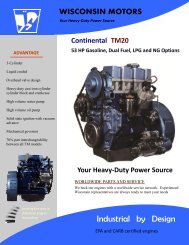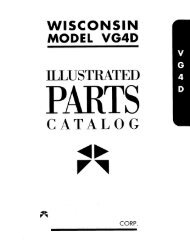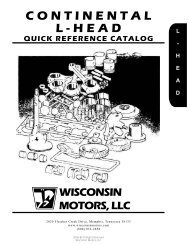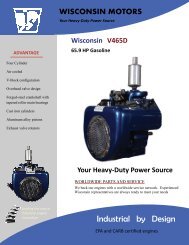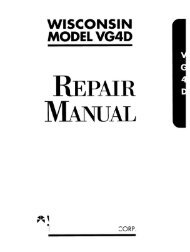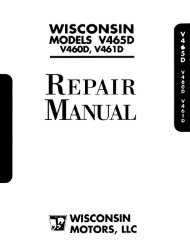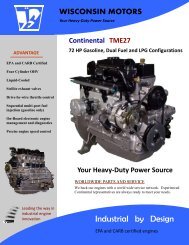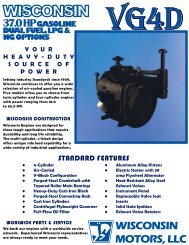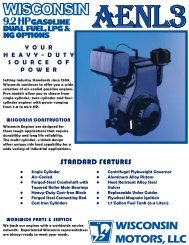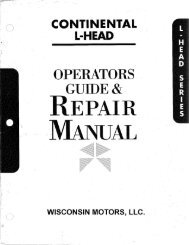REPAIR MANUAL - Wisconsin Motors
REPAIR MANUAL - Wisconsin Motors
REPAIR MANUAL - Wisconsin Motors
- No tags were found...
Create successful ePaper yourself
Turn your PDF publications into a flip-book with our unique Google optimized e-Paper software.
3. Loosen any two injector high pressure pipe nuts<br />
at the injector end. Set the accelerator to the fully<br />
open position, and with the ignition switch "on",<br />
crank the engine until fuel free from air flows.<br />
Tighten the line nuts.<br />
4. Energize the glow plugs. (Refer to page 8.)<br />
5. Start the engine.<br />
new filter element in position and replace the<br />
bowl. Tighten center stud to 6-8 lb./ft. (8-11 Nm).<br />
5. Bleed the fuel system (refer t page 22,<br />
CAVmDPA fuel system).<br />
FUEL FILTERS<br />
Clean Fuel is a Must in diesel operation. Extreme<br />
conditions may require additional filters to provide<br />
longer filter change periods - when clean fuel is not<br />
available.<br />
Continental diesels are normally equipped with<br />
the filter installed between the fuel injection pump and<br />
the transfer pump outlet- so the filter is on the pressure<br />
side of the transfer pump.<br />
The period for changing the element will largely<br />
depend upon the quality and condition of the fuel<br />
available. Under normal conditions the element<br />
should be renewed every 400 hours. This period<br />
should be decreased if unavoidable contamination of<br />
the fuel is experienced.<br />
Not : Electrical equipment such as starters should be<br />
shielded with non-conductive material during filter<br />
replacing and priming to prevent fuel entry.<br />
CAV-DPA Fuel Filter<br />
The fuel filter is of the paper element type, and no<br />
attempt should be made to clean the element. It should<br />
be replaced when periodical maintenance is being<br />
carried out or if there is reason to believe that the<br />
element is plugged.<br />
Under normal conditions, water should be drained<br />
from the fuel filter approximately once a week. Poor<br />
fuel quality and harsh work conditions can shorten the<br />
weekly drain interval to daily intervals.<br />
To drain the water from the filter, simply loosen the<br />
drain plug at the bottom of the filter assembly 1/2 to 1<br />
turn. Leave the drain plug open until water-free fuel is<br />
observed. Tighten the drain plug.<br />
Stanadyne Fuel Filter<br />
Glow Plugs<br />
Note: This fuel filter is not a water separator. If water<br />
contamination is anticipated, an additional primary<br />
fuel filter and water separator should be installed<br />
before the fuel transfer pump.<br />
No attempt should be made to clean this type<br />
element. It should be replaced at the regularly scheduled<br />
periodic maintenance interval or if there is<br />
reason to believe that it is plugged.<br />
To replace the metal canister element simply<br />
release the two spring clamps and pull the old element<br />
off the filter bracket. Lube the new element<br />
grommets with clean diesel fuel and push into place.<br />
Snap the spring clamps into position and bleed the<br />
fuel system. (Reference page 23, Stanadyne Fuel<br />
System.)<br />
Not : It is best to drain the water after the engine has<br />
been at rest for awhile. This allows the water, which is<br />
heavier, to separate and settle to the bottom of the<br />
filter. Always drain the water from the fuel filter with the<br />
engine dead and electric fuel pump off.<br />
To replace the filter element:<br />
1. Remove filter bowl.<br />
2. Discard the dirty element. Remove and discard<br />
the upper and lower element sealing washers and<br />
O-ring from the center stud.<br />
3. Clean the inside of the bowl and center tube.<br />
4. Fit the new upper and lower sealing washers.<br />
Install new O-ring on the center stud. Place the<br />
Stanadyne Fuel Filter (# TMD20FO0400)<br />
23



